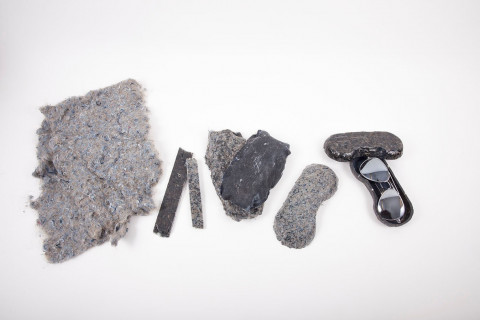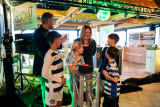RECURF focuses on the possibilities to process the new material combinations of bio-based plastics and textile residues in attractive circular products for interior and exterior uses

RECURF focuses on the possibilities to process the new material combinations of bio-based plastics and textile residues in attractive circular products for interior and exterior uses
The residents of Amsterdam produce an average of 17kg of textile waste per person per year. Of this, only 16% is collected separately. The rest end up as residual waste and will be incinerated. Only apart of the separated gathered textile is suitable for reuse or high quality recycling. The combination of textile wastefibres and bio-based plastics produce new materials with unique properties. Together with clothing collection organization Sympany, the AUAS is doing research to the possibilities of making lasting products with the discarded textiles of the inhabitants of Amsterdam. But also companies as Starbucks and Schiphol airport have textile waste flows; a unique circular product and business model arises by processing these for example in furniture for their own shops or departure and arrival halls.
RECURF focuses particularly on the possibilities to process the new material combinations of bio-based plastics and textile residues in attractive circular products for interior and exterior uses. Research is being done to:
the mechanical and aesthetic properties of new material combinations,
the appropriate processing techniques and design strategies for application of these materials ,
the circular nature of the realized designs, including environmental impact and the end-of-life scenarios'
circular business models with an interesting value proposition and revenue model for the companies involved, in order to bring designs successfully to the market.
This research project is initiated by the university of applied sciences and multiple companies within the Metropolitan Region of Amsterdam.
Get notified about new updates, opportunities or events that match your interests.

The pioneering innovations were presented of the Scale Up Future-proof artificial turf pitches project, a collaboration between Amsterdam and Haarlem focused on sustainable artificial turf pitches. Over the next few years, more than 250 sports pitches in both cities will be transformed into circular, energy-generating and climate-adaptive sports venues. These artificial turf pitches can not only generate and store energy, but also involve smart water management. An approach that is globally relevant for urban sports infrastructure.
Three consortia collaborate on the sport pitch of the future
The three selected consortia Antea Sport, EnergieVeld and GOO4iT together comprise more than 15 market players. They join forces within this innovation partnership, where there is room for long-term collaboration, co-creation and scalable innovation. The pioneering solutions will make it possible to cool down sport pitches on warm days, help dispose of and collect rainwater, make the pitches more pleasant for the users and possibly even generate energy for the surrounding area. Find out how these innovations are shaping the sport pitch of the future here.
Two municipalities: joint procurement
The Scale Up Future-proof artificial turf pitches project is a unique collaboration between two municipalities and market players. The municipalities jointly procure pooling their purchasing power and use an innovation partnership to challenge the market to test and scale up innovative and sustainable solutions. In doing so, the solutions are also scalable and transferable to other cities in the Netherlands and Europe.
From prototype to pilot fields
The first prototype fields will be constructed in Amsterdam and Haarlem in 2026, in different capacities and combining multiple innovations, where they will be extensively tested and monitored for a year. Successful concepts are then scaled up to full-scale pilot pitches and tested and monitored for another year. This will form the basis for the new standard of sustainable sports pitches, with potential for adoption in other cities around the world. At the same time, existing pitches are already being improved with the most sustainable solutions available, making an immediate impact from the start. The project thus shows how cooperation between municipalities and market players can lead to innovative, climate-proof sports infrastructure with international relevance.
Join us
This project provides cities worldwide a blueprint for sustainable, smart, and future-proof artificial turf pitches. Interested municipalities and industry partners can get in touch and subscribe to our news updates by sending an e-mail to: sportveldvandetoekomst@amsterdam.nl.

Learn with the case study Amsterdam to anticipate future food disruptions. Understand the city's food supply chain vulnerabilities is critical for enhancing food resilience. Enhance food resilience in empowerment of people in urban food growing.
Dinsdag 14 oktober 2025
11.00 – 17.00 uur
In deze verdiepende sessie ontdek je concrete toepassingen van 3D-printen.
Tijdens deze focussessie verwelkomen we:
<strong>Viktor Valk</strong>, Regional president bij Freemelt.
Viktor zal het gaan hebben over Electron Beam Melting. Een 3D-printtechnologie waarbij een elektronenbundel metaalpoeder selectief smelt, waardoor volledig dichte en nauwkeurige metalen opgebouwd kunnen worden.
<strong>Maarten van Rooij</strong>, Vice-president bij Ultimaker
Maarten gaat in op de laatste ontwikkelingen rondom materialen voor 3D-printen. Hij belicht hoe nieuwe kunststoffen, composieten en duurzame filamenten de mogelijkheden van 3D-printen vergroten.
<strong>René Tamboer</strong>, programmamanager digitalisering & circulaire maakindustrie bij TU Delft
René vertelt hoe de TU Delft onderzoek naar o.a. 3D-printen vertaalt naar concrete toepassingen voor bedrijven en de samenleving. Hij gaat in op de manier waarop nieuwe technieken en ontwerpen worden ontwikkeld in samenwerking met de maakindustrie, met aandacht voor duurzaamheid, efficiëntie en innovatie.
Je kunt individueel deelnemen aan deze focussessie, maar neem vooral je collega’s mee! Door ondersteuning vanuit het Europese programma EDIH is deelname aan deze focussessie kosteloos, wel dient er een staatsteunverklaring ondertekend te worden.


Woud they decompose?
Hi Kim,
For SandBossing (sandprinting) I need 1mm but there are many other techniques in our new industry and for these the material can be thicker. 20x20 is too small :( I have seen some amazing materials but 20x20 cm just is not big enough I need 100x100cm Not always but mostly.
But aside from the size issue which could be solved, I am interested to know if the material can be laser cut or cut with a CnC cutter? What about end of life? The circle economy is where I am headed so this is critical for me.
Thanks!
Hi Jim,
Thanks for you messages.
At the moment we can make plates of 20x20 cm, is that big enough? And what is the thickness you would need?
Regards,
Kim
Hi Kim,
I am looking for a sheet material to use for sjabloons. Would these materials be suitable.
Here is a little video of a project I am working on so that you can see what I need.
https://www.youtube.com/watch?v=WIKbYPa8xS4
Your expertise would be greatly appreciated!
Thanks